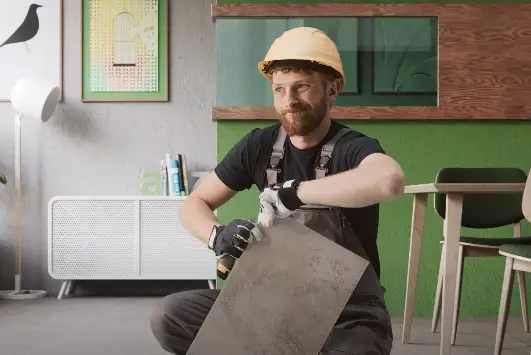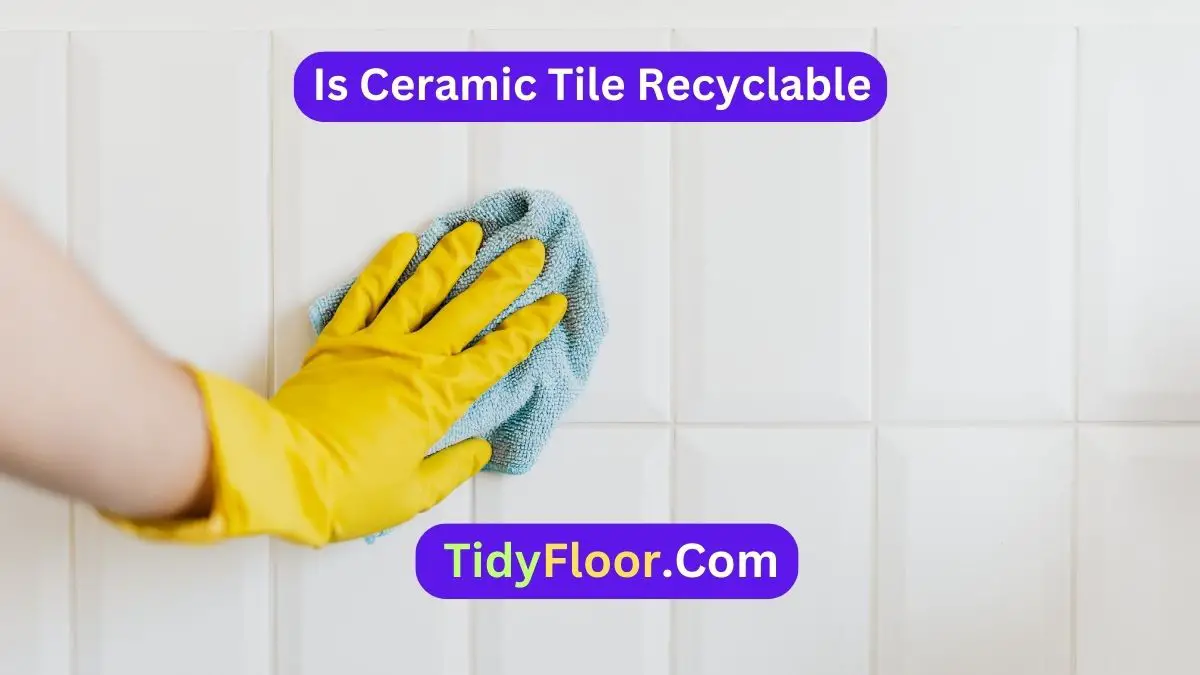Ever wondered what happens to those old ceramic tiles when you’re done with them? Is ceramic tile recyclable? Recycling is a way to give old items new life and ceramic tiles can join in on the fun too.
Ceramic tile is recyclable, but it’s not as straightforward as tossing it in your regular recycling bin. Specialized facilities may accept ceramic tiles for recycling, helping to reduce waste and conserve resources.
In this article, I’ll discuss how are they recyclable, their environmental benefits, and more. So let’s read the whole article.
How Is Ceramic Tile Recyclable?

Curious about what happens to old ceramic tiles? Step into the world of ceramic tile recycling! Discover how discarded tiles find new life through specialized processes.
1- Durable Material:
Ceramic tiles are made from durable materials such as clay, sand, and other natural minerals. This durability allows them to withstand the recycling process without significant degradation of their properties.
2- Crushability:
Ceramic tiles can be crushed into smaller pieces or ground into powder form without losing their inherent properties. This crushed or ground material can then be used as aggregate or raw material for manufacturing new tiles or other ceramic products.
3- Chemical Stability:
Ceramic materials are chemically stable, meaning they do not undergo significant chemical changes during the recycling process. This stability ensures that the recycled ceramic material maintains its quality and performance characteristics.
4- Versatility:
Recycled ceramic material can be used in various applications, including manufacturing new tiles, construction aggregates, road-based materials, and even in artistic or decorative projects. This versatility enhances the economic viability of ceramic tile recycling.
5- Environmental Benefits:
Recycling ceramic tiles reduces the demand for virgin raw materials, such as clay and sand, thereby conserving natural resources. It also helps divert waste from landfills, reducing environmental pollution and greenhouse gas emissions associated with waste disposal.
6- Energy Savings:
Recycling ceramic tiles typically requires less energy compared to manufacturing new tiles from virgin materials. This energy savings further contributes to the environmental sustainability of ceramic tile recycling.
7 Environmental Benefits Of Recycling Ceramic Tiles:
Recycling ceramic tiles provides several environmental benefits, contributing to sustainable resource management and reducing the ecological footprint of tile production and disposal. Here are some specific environmental benefits of recycling ceramic tiles:
#1- Conservation of Natural Resources:
Recycling ceramic tiles helps conserve natural resources such as clay, sand, and other minerals that are typically used as raw materials in tile production. By reusing existing materials, less pressure is placed on ecosystems and geological formations exploited for resource extraction.
#2- Reduction of Energy Consumption:
Producing ceramic tiles from recycled materials generally requires less energy compared to manufacturing tiles from virgin resources. Energy savings occur during the extraction, processing, and transportation of raw materials, as well as in the manufacturing process itself. By reducing energy demand, recycling helps mitigate greenhouse gas emissions and combat climate change.
#3- Decreased Waste Generation:
Ceramic tiles can contribute to significant waste streams, particularly in the construction and demolition sectors. Recycling these tiles diverts them from landfills, extending the lifespan of disposal sites and reducing environmental pollution associated with waste disposal.
#4- Lower Carbon Footprint:
Recycling ceramic tiles can result in a lower overall carbon footprint compared to manufacturing new tiles from scratch. This is because recycling typically requires less energy and emits fewer greenhouse gases, including carbon dioxide (CO2), during the production process. By reducing carbon emissions, recycling supports efforts to mitigate climate change and promote environmental sustainability.
#5- Protection of Biodiversity:
Extracting raw materials for tile production can have detrimental effects on ecosystems and biodiversity, particularly in areas with rich natural habitats. By using recycled materials, recycling ceramic tiles helps minimize habitat destruction, soil erosion, and disruption of wildlife habitats associated with resource extraction activities.
#6- Preservation of Water Resources:
Ceramic tile manufacturing often requires substantial amounts of water for clay processing, shaping, glazing, and firing. By recycling ceramic tiles, water consumption associated with raw material extraction and processing is reduced, contributing to the conservation of freshwater resources and mitigating water scarcity issues.
#7- Promotion of Circular Economy:
Recycling ceramic tiles fosters the principles of a circular economy by promoting resource efficiency, waste reduction, and material reuse. By closing the loop on the tile production cycle, recycling conserves resources, reduces environmental impacts, and creates economic value from discarded materials.
Ceramic Tile Recycling Processes: Step-by-step Guide
Curious about ceramic tile recycling? Explore how old tiles find new life, reducing waste and contributing to a greener future. Here is a step-by-step guide to assist you.
Materials Are Commonly Used For Recycling Ceramic Tiles:
Discarded Ceramic Tiles;
Sorting Equipment;
Cleaning Equipment;
Crushers or Shredders;
Grinding Mills or Pulverizers;
Sieving Equipment;
Additives (optional);
Forming Equipment;
Drying Equipment;
Kilns or Ovens (if applicable);
Quality Control Measures;
Packaging Materials.
Step 1: Collection
The first step involves collecting discarded or unused ceramic tiles from various sources such as construction sites, renovation projects, or tile manufacturing facilities. These tiles may be broken, damaged, or leftover from previous installations.
Step 2: Sorting
Once collected, the ceramic tiles are sorted based on factors such as size, color, and material composition. This helps in determining the suitability of the tiles for recycling and segregating them accordingly.
Step 3: Cleaning
The sorted tiles undergo a cleaning process to remove any dirt, grime, adhesives, or other contaminants. This is essential to ensure the quality of the recycled tiles and to prepare them for further processing.
Step 4: Crushing
After cleaning, the ceramic tiles are crushed into smaller pieces or aggregates using specialized equipment such as crushers or shredders. This step helps in reducing the size of the tiles for easier handling and processing.
Step 5: Grinding
The crushed ceramic tiles are then ground into finer particles or powder using grinding mills or pulverizers. Grinding helps in further reducing the size of the tiles and breaking them down into uniform particles.
Step 6: Sieving
The ground ceramic particles are sieved to remove any oversized or undersized particles, ensuring that the recycled material meets the desired specifications and quality standards.
Step 7: Mixing/Additives (Optional)
Depending on the intended application, additives or other materials may be mixed with recycled ceramic particles to enhance certain properties such as strength, durability, or color.
Step 8: Forming
The recycled ceramic particles are formed into new tiles or other products using techniques such as pressing, molding, or extrusion. This step gives shape to the recycled material and prepares it for the final manufacturing process.
Step 9: Drying
The formed ceramic products are dried to remove excess moisture and stabilize their shape. Drying can be done using natural methods such as air-drying or through mechanical means such as kiln drying.
Step 10: Firing (if applicable)
If the recycled ceramic products require firing to achieve their final properties, they are subjected to high temperatures in kilns or ovens. Firing helps in bonding the particles together and improving the strength and durability of the products.
Step 11: Quality Control
Throughout the recycling process, quality control measures are implemented to ensure that the recycled ceramic products meet the required standards for strength, durability, appearance, and other relevant criteria.
Step 12: Packaging and Distribution
Once the recycled ceramic products pass quality control checks, they are packaged and prepared for distribution to customers or retailers. Proper packaging helps protect the products during transportation and storage.
Related Questions
Can You Put Ceramic Floor Tiles In The Recycle Bin?
In most cases, ceramic floor tiles should not be placed in the regular recycling bin. Ceramic tiles are not typically accepted by municipal recycling programs due to their durability and composition, which can make them difficult to process alongside other recyclable materials.
However, some specialized facilities may accept ceramic tiles for recycling, so it’s advisable to check with local recycling centers or waste management authorities for guidance on proper disposal options or recycling opportunities for ceramic tiles.
Are Recycling Ceramic Tiles Eco-Friendly?
Recycling ceramic tiles is eco-friendly for several reasons. By diverting tiles from landfills, it reduces waste and conserves landfill space. Recycling also minimizes the need for extracting raw materials and preserving natural resources and habitats.
In addition, it requires less energy compared to producing new tiles from scratch, resulting in lower carbon emissions and reduced environmental impact. Overall, ceramic tile recycling promotes sustainability by conserving resources, reducing pollution, and mitigating climate change.
Can Recycled Ceramic Tiles Maintain The Same Quality And Durability As New Ones?
Recycled ceramic tiles can maintain similar quality and durability as new ones when produced using proper recycling techniques. By carefully sorting, cleaning, and processing recycled materials, manufacturers can ensure that the resulting tiles meet industry standards for strength, durability, and appearance.
Also, incorporating additives or adjusting manufacturing processes may further enhance the performance of recycled tiles. However, the exact quality may vary depending on factors such as the quality of the recycled material and the manufacturing processes employed.
Is There A Specific Process For Separating Ceramic Tiles From Other Waste Materials For Recycling?
There are specific processes for separating ceramic tiles from other waste materials for recycling. This typically involves manual sorting at recycling facilities or construction sites, where workers separate ceramic tiles from other debris such as wood, metal, and plastics.
Specialized equipment such as conveyor belts, screens, and sorting machines may also be used to automate and streamline the separation process. Once separated, the ceramic tiles can be cleaned, crushed, and processed for recycling into new products.
Are There Any Emerging Trends Or Advancements In Ceramic Tile Recycling Technology?
There are emerging trends and advancements in ceramic tile recycling technology aimed at improving efficiency and sustainability. One trend is the development of more advanced sorting and processing equipment to automate and optimize the recycling process, reducing labor costs and enhancing material recovery rates.
Also, research into innovative recycling methods, such as using advanced additives or alternative processing techniques, aims to improve the quality and performance of recycled ceramic tiles. Overall, these advancements contribute to the continued growth and viability of ceramic tile recycling as a sustainable practice.
Conclusion
the question of whether ceramic tile is recyclable isn’t just about its physical properties. It’s about the possibilities it holds for a sustainable future. Imagine discarded tiles finding new life as vibrant mosaics, detailed sculptures, or even eco-conscious furniture pieces. Challenges exist in the recycling process. However, advancements in technology and growing awareness of environmental issues are paving the way for a more circular approach to tile production and disposal.


